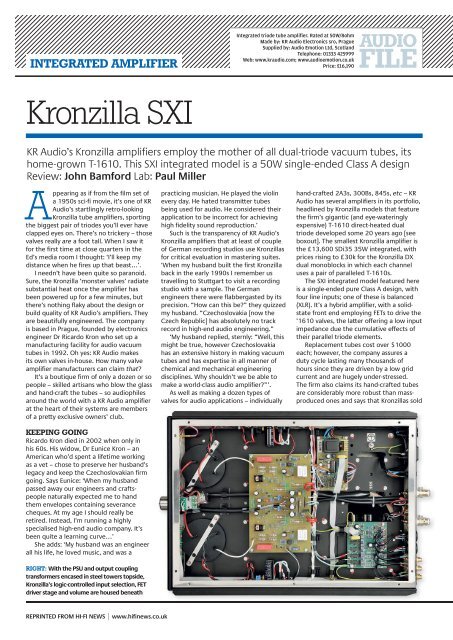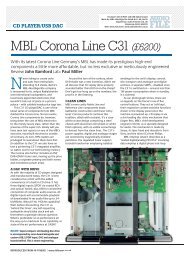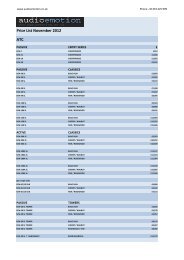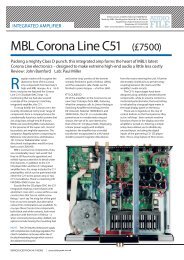HiFi News - Audio Emotion
HiFi News - Audio Emotion
HiFi News - Audio Emotion
Create successful ePaper yourself
Turn your PDF publications into a flip-book with our unique Google optimized e-Paper software.
Integrated aMPLIFIer<br />
Integrated triode tube amplifier. Rated at 50W/8ohm<br />
Made by: KR <strong>Audio</strong> Electronics sro, Prague<br />
Supplied by: <strong>Audio</strong> <strong>Emotion</strong> Ltd, Scotland<br />
Telephone: 01333 425999<br />
Web: www.kraudio.com; www.audioemotion.co.uk<br />
Price: £16,190<br />
Kronzilla SXI<br />
KR <strong>Audio</strong>’s Kronzilla amplifiers employ the mother of all dual-triode vacuum tubes, its<br />
home-grown T-1610. This SXI integrated model is a 50W single-ended Class A design<br />
Review: John Bamford Lab: Paul Miller<br />
Appearing as if from the film set of<br />
a 1950s sci-fi movie, it’s one of KR<br />
<strong>Audio</strong>’s startlingly retro-looking<br />
Kronzilla tube amplifiers, sporting<br />
the biggest pair of triodes you’ll ever have<br />
clapped eyes on. There’s no trickery – those<br />
valves really are a foot tall. When I saw it<br />
for the first time at close quarters in the<br />
Ed’s media room I thought: ‘I’ll keep my<br />
distance when he fires up that beast…’.<br />
I needn’t have been quite so paranoid.<br />
Sure, the Kronzilla ‘monster valves’ radiate<br />
substantial heat once the amplifier has<br />
been powered up for a few minutes, but<br />
there’s nothing flaky about the design or<br />
build quality of KR <strong>Audio</strong>’s amplifiers. They<br />
are beautifully engineered. The company<br />
is based in Prague, founded by electronics<br />
engineer Dr Ricardo Kron who set up a<br />
manufacturing facility for audio vacuum<br />
tubes in 1992. Oh yes: KR <strong>Audio</strong> makes<br />
its own valves in-house. How many valve<br />
amplifier manufacturers can claim that?<br />
It’s a boutique firm of only a dozen or so<br />
people – skilled artisans who blow the glass<br />
and hand-craft the tubes – so audiophiles<br />
around the world with a KR <strong>Audio</strong> amplifier<br />
at the heart of their systems are members<br />
of a pretty exclusive owners’ club.<br />
KeePIng gOIng<br />
Ricardo Kron died in 2002 when only in<br />
his 60s. His widow, Dr Eunice Kron – an<br />
American who’d spent a lifetime working<br />
as a vet – chose to preserve her husband’s<br />
legacy and keep the Czechoslovakian firm<br />
going. Says Eunice: ‘When my husband<br />
passed away our engineers and craftspeople<br />
naturally expected me to hand<br />
them envelopes containing severance<br />
cheques. At my age I should really be<br />
retired. Instead, I’m running a highly<br />
specialised high-end audio company. It’s<br />
been quite a learning curve…’<br />
She adds: ‘My husband was an engineer<br />
all his life, he loved music, and was a<br />
practicing musician. He played the violin<br />
every day. He hated transmitter tubes<br />
being used for audio. He considered their<br />
application to be incorrect for achieving<br />
high fidelity sound reproduction.’<br />
Such is the transparency of KR <strong>Audio</strong>’s<br />
Kronzilla amplifiers that at least of couple<br />
of German recording studios use Kronzillas<br />
for critical evaluation in mastering suites.<br />
‘When my husband built the first Kronzilla<br />
back in the early 1990s I remember us<br />
travelling to Stuttgart to visit a recording<br />
studio with a sample. The German<br />
engineers there were flabbergasted by its<br />
precision. “How can this be?” they quizzed<br />
my husband. “Czechoslovakia [now the<br />
Czech Republic] has absolutely no track<br />
record in high-end audio engineering.”<br />
‘My husband replied, sternly: “Well, this<br />
might be true, however Czechoslovakia<br />
has an extensive history in making vacuum<br />
tubes and has expertise in all manner of<br />
chemical and mechanical engineering<br />
disciplines. Why shouldn’t we be able to<br />
make a world-class audio amplifier?”’.<br />
As well as making a dozen types of<br />
valves for audio applications – individually<br />
hand-crafted 2A3s, 300Bs, 845s, etc – KR<br />
<strong>Audio</strong> has several amplifiers in its portfolio,<br />
headlined by Kronzilla models that feature<br />
the firm’s gigantic (and eye-wateringly<br />
expensive) T-1610 direct-heated dual<br />
triode developed some 20 years ago [see<br />
boxout]. The smallest Kronzilla amplifier is<br />
the £13,600 SDi35 35W integrated, with<br />
prices rising to £30k for the Kronzilla DX<br />
dual monoblocks in which each channel<br />
uses a pair of paralleled T-1610s.<br />
The SXI integrated model featured here<br />
is a single-ended pure Class A design, with<br />
four line inputs; one of these is balanced<br />
(XLR). It’s a hybrid amplifier, with a solidstate<br />
front end employing FETs to drive the<br />
’1610 valves, the latter offering a low input<br />
impedance due the cumulative effects of<br />
their parallel triode elements.<br />
Replacement tubes cost over $1000<br />
each; however, the company assures a<br />
duty cycle lasting many thousands of<br />
hours since they are driven by a low grid<br />
current and are hugely under-stressed.<br />
The firm also claims its hand-crafted tubes<br />
are considerably more robust than massproduced<br />
ones and says that Kronzillas sold<br />
rIgHt: With the PSU and output coupling<br />
transformers encased in steel towers topside,<br />
Kronzilla’s logic-controlled input selection, FET<br />
driver stage and volume are housed beneath<br />
REPRintEd FROM Hi-Fi nEWS | www.hifinews.co.uk
LeFt: Whopping dual-triode tubes are handcrafted<br />
featuring polished brass bases and<br />
tinted glass. Chromed buttons switch inputs<br />
via relays. Volume control is motorised<br />
in the 1990s are still going strong with<br />
their originally-fitted T-1610s.<br />
Aside from the chromed volume rotary<br />
placed centre front of the Kronzilla’s<br />
chassis, with a small red LED built into it<br />
so you can see the approximate volume<br />
position from a distance<br />
(a nice touch since<br />
it helps avoid giving<br />
your loudspeakers any<br />
unwelcome surprises),<br />
a row of buttons<br />
switch the inputs via<br />
relays. The volume<br />
control is a motorised<br />
potentiometer, the amp being supplied<br />
with a nicely formed aluminium handset<br />
tHe 12In trIOde<br />
‘The amp allows<br />
you to analyse<br />
low-end detail with<br />
forensic precision’<br />
featuring, simply, volume up/down, input<br />
up/down and power on/off keys [see p41].<br />
VIVId SOUndS<br />
Fire the Kronzilla up and a front panel LED<br />
glows red for approximately five seconds<br />
before changing to<br />
green, signalling the<br />
amp is ready to go…<br />
Yes, it may look<br />
old-fashioned, but<br />
there’s nothing<br />
antiquated about the<br />
amp’s capabilities.<br />
It sounds vivid and<br />
dynamically light-footed, with a<br />
powerful and tightly-controlled bass<br />
KR <strong>Audio</strong>’s mammoth T-1610 dual-triode is a sight to behold. Measuring<br />
310x91.5mm, with its four 25mm connector pins each the thickness of<br />
a pencil, it’s effectively two 805 triodes in one giant valve – hence the<br />
1610 nomenclature. ‘A prominent audio company approached us one<br />
day saying it wanted a substitute for the Western Electric 308B, the<br />
tooling for which had been long destroyed,’ recalls Eunice Kron. ‘It had<br />
only ever been made in small quantities and working samples today<br />
are extremely rare and very expensive. My husband offered to make<br />
something better. As an experiment he took the glass envelope of<br />
a three-element 242 tube as a base and placed inside it a triode –<br />
essentially the elements of two 300Bs. And so our ’1610 was born.’<br />
that allows you to analyse low-end detail<br />
with forensic precision, together with an<br />
open midband and sparkling highs which<br />
emanate from a black background.<br />
The renowned recording of the Oscar<br />
Peterson Trio’s We Get Requests [JVC K2<br />
remaster on the FIM label, LIM K2HD 032]<br />
sounded tremendous. The snare shuffles<br />
and hi-hat were described exquisitely by<br />
the Kronzilla while the bass was woody<br />
and satisfyingly full-bodied, the amp<br />
painting a wonderful sonic picture of<br />
the musicians’ performance and the<br />
acoustic space they occupied.<br />
In a different vein, the title track<br />
from Steely Dan’s Royal Scam<br />
album sounded similarly fresh<br />
and ‘open’. I was playing a rip<br />
of a 2008 Japanese SHM-CD<br />
[Universal UICY-93519]. The<br />
track’s elements – the piano<br />
and percussion patterns, the<br />
charmingly cheesy electric<br />
organ motifs, parping muted<br />
brass embellishments and the<br />
song’s female backing singers<br />
– were all pulled out from the recording’s<br />
rather murky production. The electric<br />
guitar positioned stage right, the sublime<br />
key to the piece, occupied its own space<br />
behind the plane of the speakers in what<br />
was a spacious sound image.<br />
And with purist recordings the SXI<br />
delivered startlingly vivid images. Playing<br />
‘Revised Music for Low Budget Orchestra’<br />
by the Omnibus Wind Ensemble, from the<br />
Danish ensemble’s Music By Frank Zappa<br />
album [Opus 3 CD 19423], revealed the<br />
Kronzilla’s ability to recreate the sound of<br />
instruments devoid of colourful adornment.<br />
I was entranced.<br />
The only listeners I can<br />
imagine not liking its precision<br />
and lucidity are lovers of SET<br />
valve amplifiers enchanted by<br />
the romance of a euphonic,<br />
rose-tinted rendition of musical<br />
events. Not that the Kronzilla is<br />
the first ever amplifier with a tube<br />
output stage to sound ballsy and<br />
agile, of course. The notion that the<br />
employment of triodes will assure a<br />
creamy and soothing sound is one of<br />
hi-fi’s misnomers, as indeed is the view<br />
that all microprocessor-controlled solidstate<br />
amplifiers reproduce music in an<br />
antiseptic fashion. Hearing this Kronzilla<br />
playing BB King’s ‘Keep It Coming’ from<br />
www.hifinews.co.uk | REPRintEd FROM Hi-Fi nEWS
LaB<br />
rePOrt<br />
KrOnZILLa SXI<br />
In many respects the Kronzilla SXI is obviously not your<br />
‘average’ tube amp but when it comes to power output, or<br />
more specifically distortion versus power output, it most<br />
certainly is. Kronzilla rates its SXI at 2x50W, a figure it achieves<br />
via its 8ohm tap into an 8ohm load providing a THD of 4%<br />
is acceptable. An output of 2x45W is possible at 2-3% THD<br />
and so on, down to 1.3% at 20W, 0.95% at 10W and 0.25%<br />
at 1W/8ohm. All these figures are at midband frequencies, a<br />
performance that holds up impressively well beyond 20kHz<br />
[see Graph 2, below] but that necessarily deteriorates at very<br />
low bass frequencies. Even here, there’s sufficient iron in those<br />
heavyweight transformers to hold distortion to just 2% at 10W<br />
output at a low 20Hz while the complement is predominantly<br />
an innocuous second harmonic.<br />
Frequency response will be influenced by the modest<br />
1.2ohm output impedance but this is very consistent from<br />
20Hz right up to the transformer resonance at a high 80kHz<br />
(also very well-damped at 2.8ohm). Into 8ohm, the system<br />
response is flat from 10Hz up to 1kHz where there’s a broad<br />
presence boost of up to +0.75dB from 2kHz–10kHz followed<br />
by a high treble roll-off amounting to –2.2dB/20kHz and<br />
–26dB/100kHz. The tube matching is superb so it’s perhaps<br />
ironic that the volume control has a relatively poor 1dB channel<br />
balance error at 1W/8ohm (re. 500mV). Noise is very low for a<br />
‘big’ tube amp and mainly at 100Hz rather than a protracted<br />
spray of 50Hz harmonics. An A-wtd S/N of 87dB (re. 0dBW) is<br />
impressive. Readers may view a comprehensive QC Suite test<br />
report for Kronzilla’s SXI by navigating to www.hifinews.co.uk<br />
and clicking on the red ‘download’ button. PM<br />
aBOVe: Four line inputs are provided, three single-ended on RCA and one balanced<br />
set on XLR. Eight and 4ohm transformer output taps are selected behind a fixed<br />
plate, feeding substantial binding posts. Input and volume are adjustable via remote<br />
Deuces Wild [MCA MCAD-11711]<br />
showcased its impressive low-end<br />
‘grip’ and vivid HF, the pumping bass<br />
and snappy percussion delivered<br />
with great exactitude. One should<br />
never judge a book by its cover.<br />
SCarILY SIMILar…<br />
I’m as much of a sucker as anyone<br />
for a relaxed, easy-going sound that<br />
invites you listen for hours without<br />
fatigue – but have you heard what<br />
a violin and/or trumpet sounds like<br />
at reasonably close quarters? When<br />
did you last stand close to a drum<br />
kit and experience the crash of a<br />
cymbal? There’s nothing polite,<br />
‘smooth’ or polished about the real<br />
sound of instruments.<br />
Hook up this SXI to a pair of<br />
serious floorstanders and you’ll<br />
likely be blown away. In PM’s media<br />
room we listened to it via his<br />
classic B&W 802s and the mighty<br />
Avalon Compás floorstanders [see<br />
p28]. We were both taken aback<br />
by the amp’s refined presentation.<br />
Neither of us expected it to sound<br />
anything like as controlled, dynamic,<br />
squeaky clean and transparent to<br />
source recordings as his pair of<br />
mono’d Devialet D-Premiers, that’s<br />
for sure. Nevertheless, these two<br />
wildly different designs shared<br />
some important traits, allowing the<br />
loudspeakers to develop a fabulously<br />
deep and wide soundstage,<br />
brimming with loads of detail and<br />
all underpinned by tightly-controlled<br />
pulsating bass information.<br />
Without going crazy with the<br />
volume control, the SXI’s musicmaking<br />
seems quite effortless<br />
and even if it is driven beyond its<br />
means there’s no obvious ‘hard’<br />
clip. Frankly, the Kronzilla SXI is a<br />
staggeringly capable amplifier, and<br />
one that provides a clear window<br />
through which to judge the fidelity<br />
of all recordings.<br />
HI-FI neWS VerdICt<br />
It’s difficult to imagine a more<br />
anachronistic looking amplifier,<br />
albeit one with modern standards<br />
of fit and finish. Yet there’s<br />
nothing old-fashioned about the<br />
sound character of the Kronzilla<br />
SXI. If you don’t mind the cost of<br />
running a Class A SET amplifier<br />
(it draws 475W at idle!) and<br />
the heat it generates, you’re<br />
bound to be enthralled by its<br />
unquestionably fabulous high-end<br />
music making ability.<br />
Sound Quality: 88%<br />
0 - - - - - - - - 100<br />
ABOVE: Dynamic power versus distortion into 8ohm<br />
(black trace), 4ohm (red), 2ohm (cyan) and 1ohm<br />
(green) speaker loads up to 5% THD<br />
ABOVE: Distortion versus frequency at 10W/8ohm<br />
(20Hz-20kHz, black) and 1W/8ohm (5Hz-40kHz, red)<br />
HI-FI neWS SPeCIFICatIOnS<br />
Power output (





